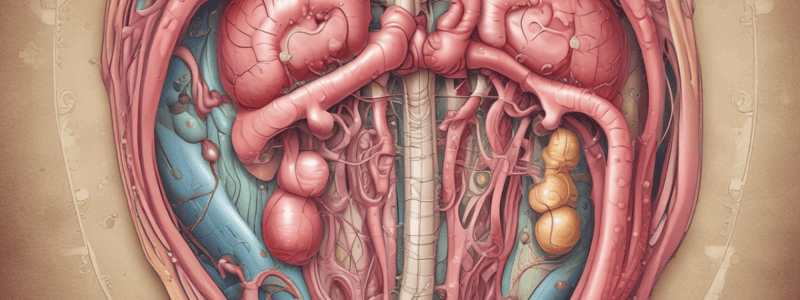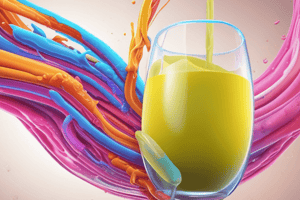Podcast
Questions and Answers
What is the primary mechanism that regulates gastric secretion?
What is the primary mechanism that regulates gastric secretion?
- Hormonal feedback mechanism
- Positive feedback mechanism (correct)
- Neuroendocrine mechanism
- Negative feedback mechanism
What is the role of pepsin in the stomach?
What is the role of pepsin in the stomach?
- To break down proteins into smaller peptides (correct)
- To activate gastric glands to increase secretion
- To break down triglycerides into fatty acids and monoglycerides
- To break down carbohydrates into simple sugars
What is the effect of increased sympathetic action potentials on gastric secretion?
What is the effect of increased sympathetic action potentials on gastric secretion?
- It increases stomach motility
- It decreases gastric secretion (correct)
- It increases gastric secretion
- It has no effect on gastric secretion
What is the role of intrinsic factor in digestion?
What is the role of intrinsic factor in digestion?
What is the effect of cholecystokinin (CCK) on gastric secretion?
What is the effect of cholecystokinin (CCK) on gastric secretion?
What is the primary function of rennin in the stomach?
What is the primary function of rennin in the stomach?
Which of the following hormones stimulates the pancreas to produce juice rich in digestive enzymes?
Which of the following hormones stimulates the pancreas to produce juice rich in digestive enzymes?
Why does the stomach absorb water and minerals?
Why does the stomach absorb water and minerals?
What is the role of the accessory pancreatic duct?
What is the role of the accessory pancreatic duct?
What is the primary function of gastric lipase?
What is the primary function of gastric lipase?
Which type of cells in the gastric glands secrete hydrochloric acid and intrinsic factor?
Which type of cells in the gastric glands secrete hydrochloric acid and intrinsic factor?
What is the primary function of the pyloric sphincter in the stomach?
What is the primary function of the pyloric sphincter in the stomach?
What is the term for the semi-liquid substance formed by the action of gastric juice on food in the stomach?
What is the term for the semi-liquid substance formed by the action of gastric juice on food in the stomach?
Which of the following is NOT a function of the stomach?
Which of the following is NOT a function of the stomach?
What is the mechanism by which the stomach lining is able to stretch as it fills with food?
What is the mechanism by which the stomach lining is able to stretch as it fills with food?
What is the primary function of lingual lipase in the oral cavity?
What is the primary function of lingual lipase in the oral cavity?
What is the purpose of the lower esophageal sphincter (LES) in the digestive process?
What is the purpose of the lower esophageal sphincter (LES) in the digestive process?
What is the principal site of pepsin digestion in the digestive tract?
What is the principal site of pepsin digestion in the digestive tract?
What is the primary site of absorption for vitamin B12 in the digestive tract?
What is the primary site of absorption for vitamin B12 in the digestive tract?
Which of the following hormones plays a key role in regulating gastric secretion and motility?
Which of the following hormones plays a key role in regulating gastric secretion and motility?
What is the primary mechanism by which gastric secretions are controlled?
What is the primary mechanism by which gastric secretions are controlled?
What type of digestion occurs in the stomach, where proteins are broken down into smaller peptides?
What type of digestion occurs in the stomach, where proteins are broken down into smaller peptides?
Which of the following best describes the movement of food through the stomach during digestion?
Which of the following best describes the movement of food through the stomach during digestion?
What is the primary site of vitamin B12 absorption in the digestive system?
What is the primary site of vitamin B12 absorption in the digestive system?
Which hormone plays a key role in regulating the digestion of proteins in the stomach?
Which hormone plays a key role in regulating the digestion of proteins in the stomach?
What is the primary function of mechanical digestion in the digestive system?
What is the primary function of mechanical digestion in the digestive system?
What is the role of digestive enzymes in the digestion process?
What is the role of digestive enzymes in the digestion process?
Which part of the digestive tract is responsible for the majority of mechanical digestion?
Which part of the digestive tract is responsible for the majority of mechanical digestion?
What is the function of the accessory organs in the digestive system?
What is the function of the accessory organs in the digestive system?
What is the approximate length of the digestive tract in humans?
What is the approximate length of the digestive tract in humans?
What is the primary function of the muscular layer in the wall of the digestive tract?
What is the primary function of the muscular layer in the wall of the digestive tract?
What is the term for the ringlike contractions followed by relaxation at multiple places along the digestive tract?
What is the term for the ringlike contractions followed by relaxation at multiple places along the digestive tract?
What is the function of the cheeks in the digestive system?
What is the function of the cheeks in the digestive system?
What is the term for the movement that propels food along the digestive tract?
What is the term for the movement that propels food along the digestive tract?
What is the function of the lips?
What is the function of the lips?
What is the inner lining of the cheeks composed of?
What is the inner lining of the cheeks composed of?
What is the function of the palate in the mouth?
What is the function of the palate in the mouth?
What is the name of the hollow space within the digestive tract through which food passes?
What is the name of the hollow space within the digestive tract through which food passes?
How many layers make up the wall of the digestive tract?
How many layers make up the wall of the digestive tract?
What is the function of the tongue in the mouth?
What is the function of the tongue in the mouth?
Flashcards are hidden until you start studying
Study Notes
Digestive System Overview
- The digestive system consists of the digestive tract and accessory organs, extending from the esophagus to the anus.
- The hollow space within the canal through which food passes is called the lumen.
- The wall of the digestive tract consists of four layers: serosa, muscular layer, submucosa, and mucosa.
Mouth Functions
- The mouth performs three main functions: intake of food (ingestion), mechanical digestion, and chemical digestion.
- The mouth is surrounded by the cheeks, palate, and tongue.
Cheeks
- The cheeks form the lateral walls of the mouth.
- The outer surfaces of the cheeks are covered with skin, and the inner surface is lined with nonkeratinized stratified squamous epithelium.
- The cheeks help hold food in the mouth, and contraction of muscles within them help produce facial expressions.
Stomach Structure and Function
- The stomach is located below the diaphragm in the left upper quadrant of the abdominopelvic cavity.
- The stomach has four subdivisions: cardia, fundus, body, and pyloric part.
- The pyloric sphincter is a thickened ring of circular smooth muscle cells that constricts to close the stomach outlet and relaxes to allow food to pass into the duodenum.
- The stomach has several specializations, including a muscular layer that allows it to mix food with gastric secretions, a thicker mucosa, and numerous gastric pits that receive secretions from gastric glands.
Gastric Juice and Gastric Glands
- Gastric juice is secreted by the gastric glands, which contain mucous neck cells, parietal cells, and chief cells.
- Mucous neck cells secrete mucus to protect the mucosa from digestive secretions.
- Parietal cells secrete hydrochloric acid (HCl) and intrinsic factor.
- Chief cells secrete digestive enzymes such as pepsinogen, gastric lipase, and rennin.
- Gastric juice converts food into chyme, a semiliquid substance, which is released intermittently into the duodenum through the pyloric sphincter.
Control of Gastric Secretion
- Gastric secretion is under neural and hormonal control.
- Parasympathetic action potentials increase with food stimuli and stimulate gastric glands to increase secretion of gastric juice.
- Gastrin, a hormone, is secreted by stomach cells and stimulates gastric gland secretion.
Pancreas
- The pancreas is located behind the pyloric part of the stomach and has both endocrine and exocrine functions.
- The pancreatic duct collects pancreatic juice, which is transported to the duodenum, where it neutralizes acidic chyme.
Control of Pancreatic Secretion
- Pancreatic secretion is controlled by both neural and hormonal mechanisms.
- Secretin, released by intestinal mucosa in response to acidic chyme, causes the pancreas to produce juice rich in bicarbonate ions.
- Cholecystokinin (CCK), secreted by intestinal mucosa in response to lipid-rich chyme, stimulates secretion of pancreatic juice rich in digestive enzymes.
Digestion by Pancreatic Enzymes
- Pancreatic amylase breaks down starch and glycogen into maltose.
- Pancreatic enzymes break down proteins into peptides and amino acids, and lipids into fatty acids and monoglycerides.
Other Organs and Processes
- The pharynx is a passageway connecting the nasal and oral cavities with the esophagus and larynx.
- The esophagus is a muscular tube that uses peristalsis to propel food toward the stomach.
- The lower esophageal sphincter (LES) guards the junction of the stomach and esophagus and relaxes to allow food into the stomach.
Studying That Suits You
Use AI to generate personalized quizzes and flashcards to suit your learning preferences.




